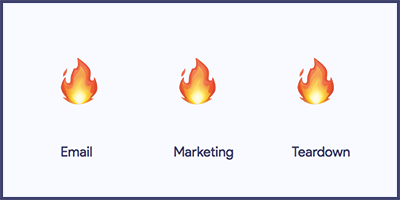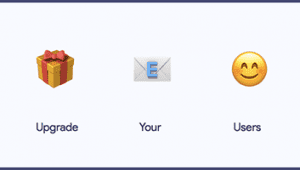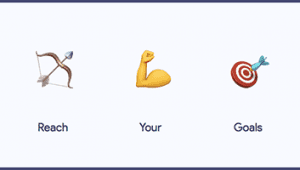Email Marketing Teardown – Hotjar
?
?
Marketing
?
Teardown
Hotjar was founded in 2014 by David Darmanin, Jonathan Vella, Erik Näslund, Marc von Brockdorff and Johan Malmberg.
In his day job as a conversion rate optimization consultant, David had seen the need for a platform to unify qualitative and quantitative data. After putting together the concept for a minimum viable product (MVP), stress-testing the idea, and opening up the beta, him and his team managed to signup 60,000 users (free trial) in 6 months.
Now, three years later, Hotjar has more than 10,000 paying customers and serves 250,000 websites. Their growth has been impressive to say the least.
Why an Email Marketing Teardown of Hotjar
When we started working on Highlights, Ludo and I had already been aware of Hotjar for a few years, but we had never used it.
We knew we’d have to do a lot of landing page optimization, and thought we could benefit from their heatmaps and qualitative research tools. We decided to set them up, and so far, we’ve been really happy with the results.
The Hotjar team is doing a lot of really good things on the product and marketing side, but how good are they really at SaaS email marketing? Let’s find out:
The Welcome Email
Like thousands of businesses, we created a company account. The first email we received was from David, their CEO, which felt like a nice personal touch. The email’s subject line was short and effective, and they used Intercom’s (they use Intercom for emails) basic email template with their company colors.

Although the use of P.S. after the signature attracts the eye (✅), the email had not one, not two, but three distinct call-to-actions:
- A webinar;
- A link to the product;
- A call for feedback.
Their main call-to-action, “Sign into your account here”, was soft and didn’t really offer a compelling reason to access the software at this moment.
After sign up, Hotjar recommends creating individual accounts. Since we did that, it meant that I received every email covered in this post twice.
I ended up unsubscribing one of the accounts. A bit of automation logic could have prevented that.
So, for a lot of Hotjar users, the product experience begins with the following email (sent from Hotjar):

The email is clear and concise. The button is very click-able, but if I’m a corporate user and I don’t know what Hotjar is, there’s nothing motivating me to join. What’s in it for me?
Although the subject line is good, a bit of personalization in the subject line (e.g. John invited you to join Hotjar.) could help improve the open rate.
The Onboarding Emails
After the Welcome email, and following a strange 6 days without emails, Hotjar launches into a 7-email Training & Tips sequence. The emails, sent from David, are designed to help users discover the full value of the product.
I received a slightly different sequence of emails for my 2 accounts. As Hotjar states in the first email, “they only send messages about tools they see we haven’t used”.
It’s a good use of Intercom’s Smart Campaigns feature. It helps keep the emails fresh and interesting.
Most of the onboarding emails we received had strong subject lines, meant to stir curiosity:
- Day 6 – ? “Heatmaps for your Key Pages”
- Day 7 – ? “Get instant visual feedback from your visitors”
- Day 12 – ? “What is missing on your site?”
- Day 14 – ? “How to survey your customers…”
- Day 16 – ? “The biggest barriers on your site”
- Day 18 – ? “The right question to ask your abandoning visitors…”
- Day 20 – ? “Quick Usability Tests with your users…”
Onboarding Email Breakdown

Hotjar’s onboarding emails are long-form. They feel like tutorials more than transactional emails.
To help drive action, the emails have clear CTAs and feature quick and easy (with estimated time and difficulty level!) improvements users can make on their websites.
The emails have several links pointing in different directions (documentation, product, website, etc). Having one clear call-to-action leading to the product, and then giving users additional resources in-product might be more effective though.

The second email we received had broken image links. It’s a good reminder to always test your emails in different inboxes. ?
For long emails like these, it’s also a good idea to repeat the buttons.
The sub-titles in the onboarding emails (e.g. Discover your Visitors’ Drivers) were useful to help quickly assess the content of the email.

It might be a decision motivated by branding, but Hotjar’s onboarding emails feel a bit long-winded with both introduction and concluding paragraphs.
Long emails feel… long. To me, if an email is long, it’s unlikely I’ll get to it right away. This, in turn, defeats the purpose of trying to make the email actionable…
The Upsell Email
Hotjar is free to try. When we set it up for Highlights, we signed up to a 15-day trial of the Plus plan.
Part of the goal with onboarding emails is to get the users to the aha moment – moment of realization of value – and convince them to upgrade to a paid plan.
I was happy to keep receiving training emails even though we didn’t upgrade to a paid plan. In Freemium, many users actually convert several days (or weeks) after the trial is over.

Even with that in mind, I was expecting a stronger upsell email from Hotjar.
The email we received was more informational than anything else. It arrived after the trial was over, and was sent by Hotjar, not a human (upsell emails from humans often convert better).
The email was probably sent from a transactional email platform like SendGrid or Mailgun. It had a bad subject line (83 according to this subject line tester! ?), did not provide a reason to upgrade, and did not have a clear call-to-action.
We are getting value from Hotjar. Why not try to get money from us?
The Feature Update Email
Feature update emails are great to reengage or reactivate users. They show momentum, and demonstrate that the company is listening and improving the product.
Hotjar sends new features update emails frequently. Although some of their features felt small-ish, the use of animation (GIFs) to communicate the change and the clear explanations of the benefit of the change were good.
It’s hard to know why they use a different email template for feature updates, but the use of a different sender (Andrew from the customer experience team) and a photo in the signature made the email feel more human.

The use of emojis (e.g. ???) in the following feature update email’s subject lines was a nice touch. It often has a positive impact on the open rate.
Email recipients often click images. It’s a good idea to add links on images and link within the app, as opposed to to external resources.

SaaS Email Marketing Teardown – Takeaways
No email marketing program is perfect. Let’s look at what Hotjar is doing well… and less well:
The Good
- ✅ Good use of email marketing automation to manage the onboarding sequence;
- ✅ Emails use GIF animations and clear visuals to communicate concepts and information;
- ✅ Emails are relevant and usually explain the user/customer benefit;
- ✅ Subject lines are effective, and help create engagement and curiosity;
- ✅ Buttons are clear. Use of time estimates and simple tasks help drive user behavior.
The Bad
- ❌ Some of the emails (especially the transactional emails) don’t have clear goals or drive to key actions;
- ❌ Some emails lack focus, and have competing call-to-actions;
- ❌ Different templates are used for similar emails; there could be more consistency;
- ❌ Some emails are a bit long-winded;
- ❌ Not all email links have tracking.
Email Marketing Teardown – Score
Interested in building an email program like Hotjar?
We just launched a SaaS Email Masterclass ? to help increase trial conversions with email.
Hotjar is doing a lot of really good things with emails. Their training and informational emails are very effective. However, having more of a central view of their SaaS email marketing program might help create more consistency.
To truly get results with email marketing campaigns, it’s important that the transactional, onboarding and informational emails all push in the same direction.
Transactional emails in particular are great opportunities to drive user behavior. With soft call-to-actions and the absence of upsells in transactional emails (like the one below), Hotjar shows it still has room to improve the performance of its email marketing program:
Final score: 7.3/10 ?

Do you agree with us? Let us know in the comments below.?





Hey Etienne
This is a super timely teardown as we are about to start re-working our onboarding emails at Hotjar.
I think you might have been a little generous with the 7.3 but we will take it 🙂
Some great tips we are already working on and some others you have bought to our attention with this teardown.
Thanks for the great feedback!
Great! I’m glad this was helpful to you guys. 🙂